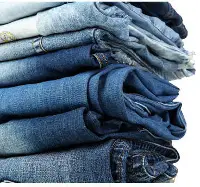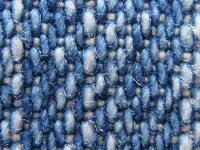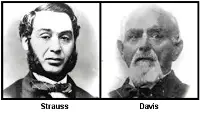|
Why Is It That Jeans Are Blue? 
Jeans are commonplace for many generations of people today–in America, especially, but also in many other countries. Jeans come in many colors these days, but the most common color is the original, blue. Why? The pants or trousers known as jeans were the product of an inventive partnership between Jacob Davis and Levi Strauss. In a process familiar with many other inventions, they didn't start from whole cloth, as it were, but built on the work of others. One very common fabric used in the making of jeans is denim. One suggestion for where the word "denim" came from is from the French language. Specifically, the city of Nîmes was the setting for much production of a fabric used to make trousers. That fabric became so associated with the city in which it was made that it came to be called "from Nîmes," or, in French "de Nîmes." And, as the theory goes, "de Nîmes" over time became shortened (or corrupted) to "denim." This fabric from Nîmes was similar to another fabric, this one made from cotton, from the Italian city of Genoa. Genoese sailors and others wore trousers made from such fabric because it could be worn wet or dry. And, to complete the French connection, the word for Genoa in the French language is "Gênes." 
But that's why denim jeans are called denim jeans. Why are they, more often than not, blue. The color of blue comes from the dye used in the making of the jeans, and that dye was made from indigo, which is a plant that gives a product that is blue. 
In the late Middle Ages and in the 19th Century, as textile production increased across the European continent and trade between Europe and Asia increased, one trade route that became prominent was the shipping of indigo dye from India to Europe. Nîmes, as a major manufacturing center in France, was one of the places to which much Indian indigo dye was shipped, and trousers manufacturers found that the indigo dye more solidly bonded with the fibers of the denim. Unlike other dyes, which when heated penetrated the cotton fibers, dye attached to the outside of the fabric. And with each wash, the indigo dye more solidly bonded with the fabric, making the jeans softer and creating the softened blue look that is now so familiar. In the late 19th Century and early 20th Century, Nîmes merchants were exporting more and more indigo-dyed material to the United States. One of the people inspired to use that fabric to make trousers in America was Levi Strauss, a Bavarian immigrant. He and Jacob Davis created what we now recognize as the first American blue jeans and received a patent for their invention in 1873. Their main difference was the addition of rivets to make the trousers sturdier than what had come before. 
Strauss had come from Germany to New York in 1851 and had moved to San Francisco in 1853, to capitalize on the California Gold Rush. Strauss owned a dry goods business, and Davis was a tailor who was one of Strauss's customers. It was actually Davis's idea to add the rivets, which were copper. 
The invention came just in time for the last phase of the settlement of the American West, and people to this day continue to buy blue jeans. Production methods are different, of course, as is the way that the indigo dye is made. Today's dye is synthetic. But in many ways, the look and feel haven't changed. What has changed is that the number of manufacturers has increased in a big way and the number of people who wear jeans–blue or otherwise”has increased exponentially. Have a suggestion for this feature? Email Dave. |
Social Studies for Kids |





